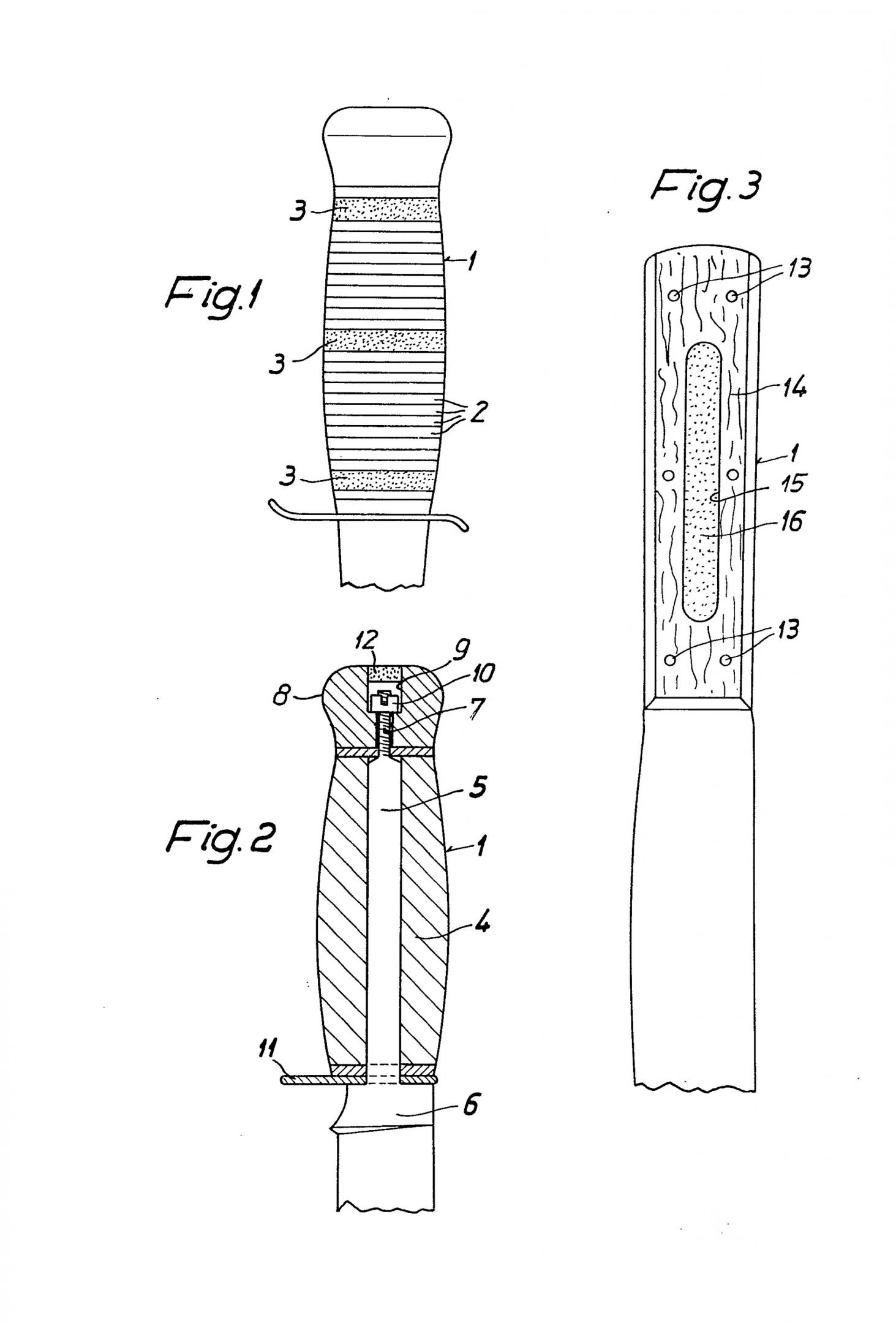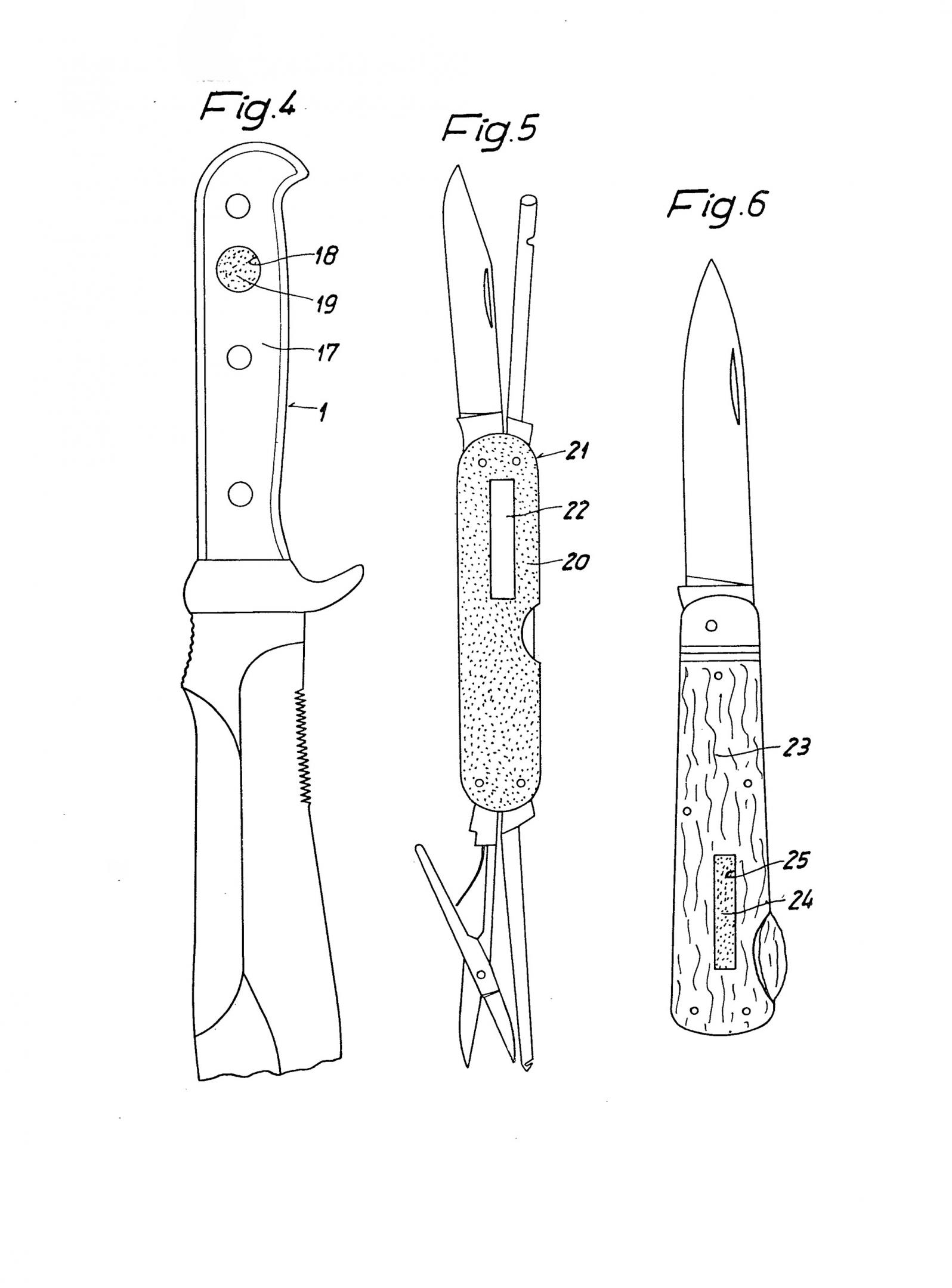Patents: Handle for a cutting tool
Knife inventions are by no means always related to the shape or mechanism of the blade. In April 1959 Puma-Werk Lauterjung & Sohn in Solingen was granted a patent for the handle of a cutting tool, part of which was provided with a luminous substance. This would make it easier to find the knife or tool in the dark.
In April 1959, Puma-Werk Lauterjung & Sohn in Solingen was granted German patent 1 787 913 for a 'Handgriff für ein leichtes Gebrauchsgerät oder -werkzeug aus Metall' (Handle for a light metal utility device or tool). This somewhat formal description mainly referred to the handle of knives, as shown in the accompanying drawings.
The idea was simple: the handle was provided with a luminous substance, or largely made of that substance, to make it easy to find the knife in the dark, for example if it had slipped out of one's hand. This was especially useful in situations where no torch or lighter could be used, such as when hunting. According to the patent, the luminous material was commercially available without problems; it was just a matter of using it as effectively as possible. Which luminous material is meant is not clear.
The patent describes and depicts six different applications. Figure 1 shows a dagger with a grip of leather or plastic discs (2), some of which have been replaced by discs of luminous material (3). A variant of this, in figure 2, is a dagger with a solid grip, where a piece of luminous material (12) has been put in the back of the grip.
Figure 3 shows the handle of a knife with two stag handle scales (14) fitted with a recess filled with luminous material (16). In figure 4, the handle has a piercing in which a plug of luminous material (19) is placed.
With the fishing knife in figure 5, the entire handle (20) is made of luminous material, with a recess filled with non-luminous substance (22) as a contract. Finally, figure 6 shows a hunting knife where the stag horn handle scales are fitted with a small strip of luminous material (24), similar to the knife in figure 3.
As mentioned, Puma's patent does not answer the question of which luminous material was used. It could be that radium was used for this purpose. This would then have meant a quick end to the new products, as the use of radium was banned in 1968 because of the radiation hazard. Meanwhile, there are many advanced and harmless luminescent substances. Perhaps a good idea to revive Puma's designs?
In April 1959, Puma-Werk Lauterjung & Sohn in Solingen was granted German patent 1 787 913 for a 'Handgriff für ein leichtes Gebrauchsgerät oder -werkzeug aus Metall' (Handle for a light metal utility device or tool). This somewhat formal description mainly referred to the handle of knives, as shown in the accompanying drawings.
The idea was simple: the handle was provided with a luminous substance, or largely made of that substance, to make it easy to find the knife in the dark, for example if it had slipped out of one's hand. This was especially useful in situations where no torch or lighter could be used, such as when hunting. According to the patent, the luminous material was commercially available without problems; it was just a matter of using it as effectively as possible. Which luminous material is meant is not clear.
The patent describes and depicts six different applications. Figure 1 shows a dagger with a grip of leather or plastic discs (2), some of which have been replaced by discs of luminous material (3). A variant of this, in figure 2, is a dagger with a solid grip, where a piece of luminous material (12) has been put in the back of the grip.
Figure 3 shows the handle of a knife with two stag handle scales (14) fitted with a recess filled with luminous material (16). In figure 4, the handle has a piercing in which a plug of luminous material (19) is placed.
With the fishing knife in figure 5, the entire handle (20) is made of luminous material, with a recess filled with non-luminous substance (22) as a contract. Finally, figure 6 shows a hunting knife where the stag horn handle scales are fitted with a small strip of luminous material (24), similar to the knife in figure 3.
As mentioned, Puma's patent does not answer the question of which luminous material was used. It could be that radium was used for this purpose. This would then have meant a quick end to the new products, as the use of radium was banned in 1968 because of the radiation hazard. Meanwhile, there are many advanced and harmless luminescent substances. Perhaps a good idea to revive Puma's designs?

